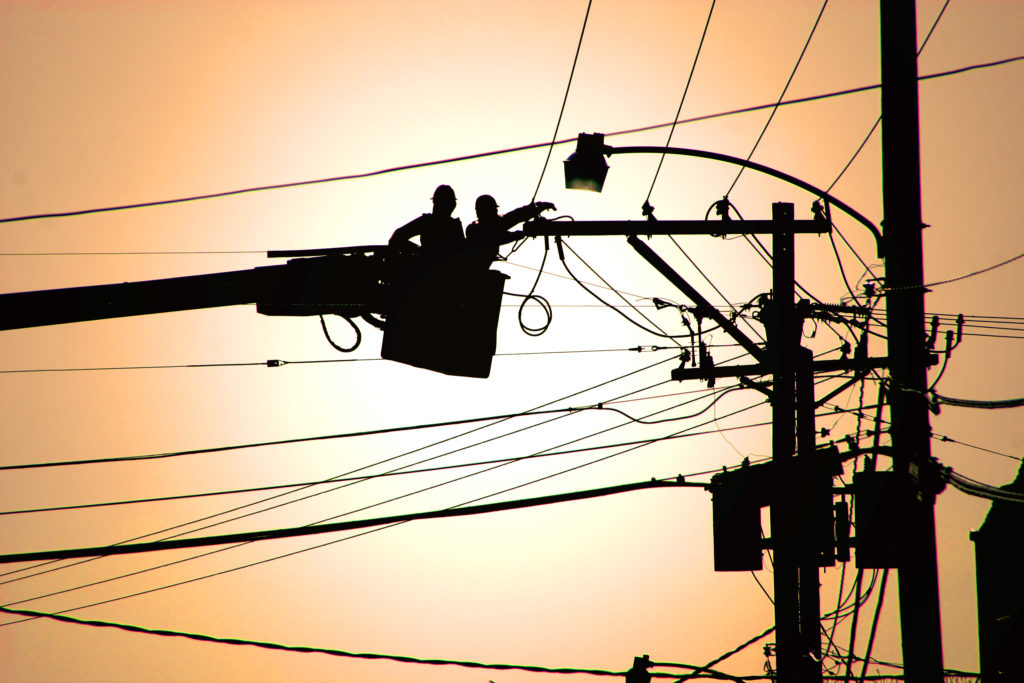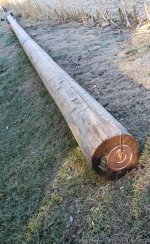Over the last few years, we have been doing T-Mobile and Verizon small cells on utility poles and street lights. The utility standards put out for work on the power company poles are the guidelines we must follow. One thing is to use the pole ground as the GEC. We use a copper C and crimp the wire that runs from utility neutral to the one rod at the base. The city electrical inspector would not sign off without the two ground rods so we installed an additional one. The standards called for SCH 40 PVC conduits from the ground up on the opposite side of the pole from traffic. The inspector called out exposed to physical damage. The car would have to go thru the utility pole to get damaged Schedule 80 or not, regardless we changed it. I don't think the utility will care about the SCH 80. The third item was additional support on the pole. The utility standard requires the standoff on the poles to be 8' above finished grade this is to keep someone from walking into the end and getting hurt. NEC requires support at 5' so we added a standoff bracket below 5' from the ground. I believe the utility is going to reject the site or just remove the bracket. I had this case once before out of probable about 100 sites. The services are 15' in the air this one went down to go up a different pole across the street. Most go up to an aerial strike. Even in the air above 15' the utility freaks out if we place a standoff every 5' on their poles but certain inspectors only care about the NEC standard regardless of it being on the utility pole. Utilities are excluded from the NEC. Thoughts about a lease agreement on the poles and NEC jurisdiction? The plans from the utility are stamped engineered documents. At this point, we just do what the inspector asks and pass it off, and then do what the utility says to appease them. I feel that the NEC should only apply to the electrical service enclosure that it installed safely and correctly per the NEC with the Neutral bonded to the GEC, labeled, AIC and arc flash, etc. The utility pole and conduits are part of the utility.
You are using an out of date browser. It may not display this or other websites correctly.
You should upgrade or use an alternative browser.
You should upgrade or use an alternative browser.
NEC vs utility standards
- Thread starter Jeff.Long
- Start date
- Status
- Not open for further replies.
Greentagger
Senior Member
- Location
- Texas
- Occupation
- Master Electrician, Electrical Inspector
Grounding and bonding of service equipment definitely in scope of NEC. I dont recall the copper wire going down utility pole for their(Utility) GES mentioned in NEC as one of required electrodes?
- Location
- Wisconsin
- Occupation
- PE (Retired) - Power Systems
Just because something is owned by a utility does not mean an installation is not subject to the NEC.
- Location
- Illinois
- Occupation
- retired electrician
True, but the NEC should never be used to change safety requirements of the NESC for a raceway installed on a utility pole. The 8' to the first support for the raceway is a safety requirement and the support lower than that should not be permitted.Just because something is owned by a utility does not mean an installation is not subject to the NEC.
- Location
- Bremerton, Washington
Our poco requires first support at the bottom and the next at 8 ft, for a service riser on a pole. Supports every 5 ft per the NEC would allow someone to climb up, be shocked, etc.That persons estate would have a very good case for damages from AHJs agency.
- Location
- Wisconsin
- Occupation
- PE (Retired) - Power Systems
I agree.True, but the NEC should never be used to change safety requirements of the NESC for a raceway installed on a utility pole.
Buck Parrish
Senior Member
- Location
- NC & IN
- Location
- Placerville, CA, USA
- Occupation
- Retired PV System Designer
I have seen this pole grounding technique described before. Looks efficient.
RumRunner
Senior Member
- Location
- SCV Ca, USA
- Occupation
- Retired EE
It is true that there is a demarcation line between NEC (National Electrical Code and NESC (National Electrical Safety Code.)Over the last few years, we have been doing T-Mobile and Verizon small cells on utility poles and street lights. The utility standards put out for work on the power company poles are the guidelines we must follow. One thing is to use the pole ground as the GEC. We use a copper C and crimp the wire that runs from utility neutral to the one rod at the base. The city electrical inspector would not sign off without the two ground rods so we installed an additional one. The standards called for SCH 40 PVC conduits from the ground up on the opposite side of the pole from traffic. The inspector called out exposed to physical damage. The car would have to go thru the utility pole to get damaged Schedule 80 or not, regardless we changed it. I don't think the utility will care about the SCH 80. The third item was additional support on the pole. The utility standard requires the standoff on the poles to be 8' above finished grade this is to keep someone from walking into the end and getting hurt. NEC requires support at 5' so we added a standoff bracket below 5' from the ground. I believe the utility is going to reject the site or just remove the bracket. I had this case once before out of probable about 100 sites. The services are 15' in the air this one went down to go up a different pole across the street. Most go up to an aerial strike. Even in the air above 15' the utility freaks out if we place a standoff every 5' on their poles but certain inspectors only care about the NEC standard regardless of it being on the utility pole. Utilities are excluded from the NEC. Thoughts about a lease agreement on the poles and NEC jurisdiction? The plans from the utility are stamped engineered documents. At this point, we just do what the inspector asks and pass it off, and then do what the utility says to appease them. I feel that the NEC should only apply to the electrical service enclosure that it installed safely and correctly per the NEC with the Neutral bonded to the GEC, labeled, AIC and arc flash, etc. The utility pole and conduits are part of the utility.
If the two agencies (POCO and Building and Safety) belong to the city-- like we do here in City of Los Angeles -- where AHJ Building and Safety and POCO Department of Water and Power are both owned by the City—they hold the discretion on who inspects the project.
LADWP (Los Angeles Department Of Water and Power) is the largest municipal-owned utility-- a revenue earning entity.
With 2 million customers-- they are something to reckon with.
And in most cases projects are handled by the same inspector.
So, what is good for the goose is good for the gander.
You don’t say what city this project is located-- so it is hard to say whether the above apply to your predicament.
NEC pertains to HOW things should be installed -- NESC pertains to WHAT needs to be installed.
This separation is meant to DELINEATE what is covered by each entity.
Encroaching the demarcation line by any of these two divisions would cause ambiguity in assigning who is responsible in case of conflicts.
NEC stops at the point of connection to the user. NESC is only concerned about how power is distributed (and its safety aspects) from the pole to the consumer.
Sometimes it is up to the design engineer to relegate who would perform the task.
So, logically everything on that pole is under the scope of the NESC.
Here is more information regarding this conundrum:

Working With Electricity: How the NESC Differs From the NEC - IEEE Innovation at Work
For anyone working with electricity, a basic summary to the fundamental differences between the National Electrical Safety Code (NESC) and the National Electrical Code (NEC).
The City is Bellevue Washington.It is true that there is a demarcation line between NEC (National Electrical Code and NESC (National Electrical Safety Code.)
If the two agencies (POCO and Building and Safety) belong to the city-- like we do here in City of Los Angeles -- where AHJ Building and Safety and POCO Department of Water and Power are both owned by the City—they hold the discretion on who inspects the project.
LADWP (Los Angeles Department Of Water and Power) is the largest municipal-owned utility-- a revenue earning entity.
With 2 million customers-- they are something to reckon with.
And in most cases projects are handled by the same inspector.
So, what is good for the goose is good for the gander.
You don’t say what city this project is located-- so it is hard to say whether the above apply to your predicament.
NEC pertains to HOW things should be installed -- NESC pertains to WHAT needs to be installed.
This separation is meant to DELINEATE what is covered by each entity.
Encroaching the demarcation line by any of these two divisions would cause ambiguity in assigning who is responsible in case of conflicts.
NEC stops at the point of connection to the user. NESC is only concerned about how power is distributed (and its safety aspects) from the pole to the consumer.
Sometimes it is up to the design engineer to relegate who would perform the task.
So, logically everything on that pole is under the scope of the NESC.
Here is more information regarding this conundrum:

Working With Electricity: How the NESC Differs From the NEC - IEEE Innovation at Work
For anyone working with electricity, a basic summary to the fundamental differences between the National Electrical Safety Code (NESC) and the National Electrical Code (NEC).innovationatwork.ieee.org
WashingtonVery true I did not thing about the Access issue.Our poco requires first support at the bottom and the next at 8 ft, for a service riser on a pole. Supports every 5 ft per the NEC would allow someone to climb up, be shocked, etc.That persons estate would have a very good case for damages from AHJs agency.
- Status
- Not open for further replies.


